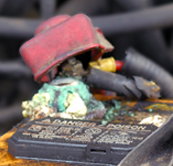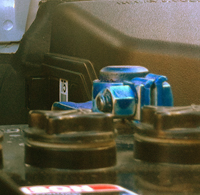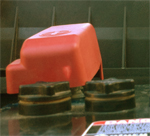
Corroded battery terminals often mean your car will not be running at its peak but there is an appropriate way to clean them to ensure it is as safe and environmentally friendly as possible.
Mixing water and baking soda is a common home remedy for removing corrosion from battery terminals but considering water and electricity do not mix it isn’t the safest solution. A 12 volt shock may not seem too dangerous to you, it will cause damage to your car by discharging sensitive electronic devices.
Here is a method that will not cause damage to your car but we must warn you, the following tips involve working around and near acid and involve chemical reactions producing heat. Please take all care to ensure your safety. If you are not confident in your ability to handle dangerous substances, seek professional advice from a certified mechanic. Wear protective eyewear, gloves and suitable clothing. If acid comes in contact with your skin or eyes, flush with warm water for at least fifteen minutes and seek immediate medical advice.
Step 1: Disconnect the battery
Always remove the cables from the battery terminals in the correct order to avoid damage to any sensitive electronic components within the car. DO NOT touch both terminals at once.
Remove the clamp from the grounded terminal first and then disconnect the ungrounded terminal. The grounded terminal is the one connected by a wire to the body of the car or engine (some cars may have a positive earth). Removing the grounded clamp first will help further protect against any accidental damage to your electrical system by preventing accidental grounding or static sparking from the positive terminal.
The more corrosion apparent on the clamps or terminals, the harder they will be to remove, a pair of vice grips may be helpful to work them loose. Be patient and avoid putting too much pressure on the clamps as they break easily. Gently wiggle them until they are loose enough to remove, then secure them safely out of the way.
Step 2: Examine clamps and cables
Examine the clamps and cables for excessive corrosion or any signs of damage (splits or frays in cable, cracked or broken clamps etc) and replace them if necessary. Good contact of clamp to terminal is pointless if the cables or clamps are in poor condition.

Check the point where the cable enters the clamp for any signs of corrosion. Corrosion can work its way up inside the cable. Excessive amounts of blue/green or white powdery residue inside or around this join can indicate the cable should be either cleaned or replaced.
Tap the clamps gently with a screwdriver or spanner and observe if any powder falls out. DO NOT breathe this powder in, it is essentially crystallised acid and is very harmful if inhaled.
Step 3: Examine the battery
Examine the entire battery casing for any signs of damage or warping and particularly cracking. If you notice any issues it is would be best to replace the battery, keeping in mind that modern batteries are mostly recyclable.
Ideally you should remove the battery entirely before cleaning the terminals, but this is not imperative. Do your best to check in place under these circumstances.
Step 4: Examine the terminals/clamp connection
A smooth, clean connection is desirable between the clamps and battery terminals to maximise conductivity. Check the terminals themselves for any signs of damage such as heavy scoring or overly pitted surfaces (many tiny holes).
Pitting may not look too bad on the surface but there is no way of knowing how deep into the terminal the corrosion that caused it has penetrated. If the damage is excessive and you are having other problems (excessive corrosion, battery constantly going flat or issues starting the car when cold), it is a good indicator that it is time to consider a new battery or seek professional advice.
Ask your preferred mechanic for their opinion, they may be able to file back the terminals and fit new clamps or recommend other solutions.
Step 5: Neutralise the sulphuric acid
Pour a small amount of baking soda directly onto dry terminals instead. Not too much, it should leave a nice ring of baking soda around each one. Baking soda helps to neutralise the sulphuric acid (which is toxic) before it is rinsed away, preventing it from causing accidental burns, harming the environment or damaging any components in your engine bay (or your paintwork).
DO NOT use a mixture of water and baking soda to clean battery terminals.
Step 6: Cleaning, soft brush
Now take a container of water and use a soft brush to apply the water gently to the rings of baking soda, avoid splashing the mix around as much as possible. A soft brush holds more water than a stiff one, making it easier to apply. Clean paint brushes are perfect for the task.
The baking soda will begin to fizz as it reacts with the acid in the corrosive deposits. Allow it to fizz for a few seconds to ensure as much acid is neutralised as possible before proceeding.
Step 7: Cleaning, hard brush

Next, take a slightly harder brush, such as an old toothbrush or a specialised terminal cleaning brush. Carefully scrub the baking soda and water mix onto the terminal posts, avoid splashing in case any acid is still active.
Clean the cable clamps inside and out as well, paying particular attention to the inside of the clamp where the connection with the terminal is made.
Step 8: Final clean
Once the mixture has stopped fizzing completely you can rinse the terminals with a little water or just wipe up the remaining mix with a clean rag.
DO NOT get it on your hands, the car or your clothes. Even diluted sulphuric acid can cause painful burns and the reaction is exothermic, meaning it can create heat and effectively increase the severity of any burn you do get. Hopefully your terminal should now look something like this.
Step 9: Apply petroleum jelly

The application of petroleum jelly to the battery terminals will prevent further corrosion. It also makes reconnecting the clamps much easier.
Step 10: Re-connecting the battery
Replace the positive clamp and then the negative clamp. Use a proper sized spanner to tighten them to avoid stripping them. Be sure to replace the rubber boot or plastic shield to help prevent further corrosion.
Read this article to learn more about why battery maintenance is so important to the running of your car.